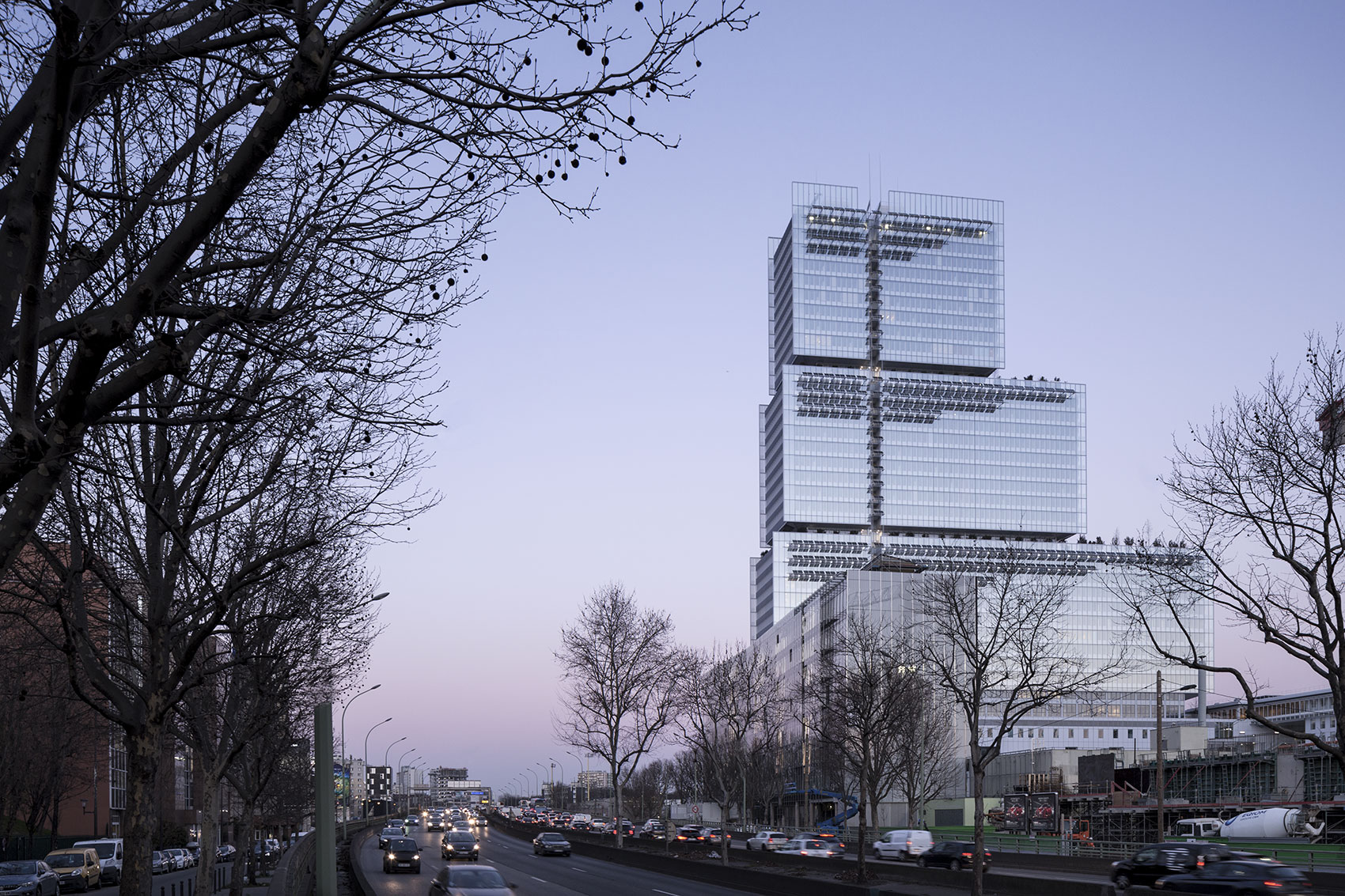Tell It to the Judge
by James McAuley

The new Tribunal de Paris, designed by Renzo Piano, as seen from the Boulevard Périphérique. Photo: Stefano Candito.
Strictly speaking, a salle des pas perdus is a large open space at the entry of a French civic building, a kind of indoor piazza that serves as a conduit between a public edifice and the public it serves. But the term — “the room of lost steps” — has a particular meaning in France’s courthouses, where it describes the central halls in which people confer with their lawyers and await the verdicts that seal their fates. The one inside Paris’s old, dusty Palais de Justice, on the west end of the Île de la Cité, is a classic salle des pas perdus: a long, shadowy corridor topped by a vault of marble, an antechamber of listless anxiety, where one paces back and forth, walking for miles without ever going anywhere. It’s the kind of place that communicates the weight of the Republic more than its romance.
This past April, Paris’s entire court system relocated, after centuries in the middle of the Seine, to a towering structure of glass — designed by Renzo Piano, born in Genoa but a longtime Parisian — that sits at the northwest edge of the city. The new Tribunal de Paris is now Europe’s largest justice complex, a staggering 160 meters tall, and as you drive by it on the Boulevard Périphérique it has the look of a modern-day ziggurat, a stair-step ascent of transparent glass panels meant to capture the light. But the essence of it all, undeniably, is Piano’s vast salle des pas perdus. On a bright spring day, I was lost in the whiteness of it all: the concrete floor, the unimpeded stream of sunlight, and the elevators that seem to soar to the sky. If Piano’s rendition still serves the classic purpose of offering visitors a waiting room, it is no purgatory: few boundaries divide it from the private offices and courtrooms whose existence make this room, at least in theory, a space of transience.

In that sense, the Tribunal bears a striking similarity to Piano’s earlier intervention into Parisian modernity: the Centre Pompidou, a monolithic structure with a simple volume that instantly reveals — to those who enter as well as those who do not — both its function and its organization. The same is true in the Tribunal: the private spaces are ultimately accessible through a visible network of open-air, never-ending staircases, seemingly from the imagination of M.C. Escher. Likewise, the glass sheaths that stream light onto the vestibule’s white and as yet unspoiled concrete floor are ultimately the same sheaths that stream the same light throughout the enormity of the structure. “From the salle des pas perdus, the light is diffused throughout the building,” he recently told Le Monde. “The 2,000 magistrates who will be going to work there were accustomed to darkness; they have a luminous office today. That does not mean that they will do justice better, but it certainly helps. Light serves this purpose.”

Museumgoers already know about Piano’s light obsession, carried through from the Menil Collection in Houston to the new Whitney in New York. But he also seems to imagine literal transparency as a means to inspire figurative transparency, especially in the realm of the law. He is not alone. In 1998 Richard Rogers — Piano’s collaborator on the Pompidou — inaugurated a strikingly similar courthouse in hopelessly bourgeois Bordeaux. “It is not enough to do justice,” Rogers said at the dedication of that courthouse, made of glass, steel, and wood; “we must see that justice is rendered.” Fair enough. But the Bordeaux courthouse has not fared especially well; after just a year its tempered glass girders burst and had to be replaced with metal beams. Judges and clerks in Bordeaux complain that the architecture’s attempts to symbolize justice have merely disturbed productivity. One wonders if Piano’s will meet a similar fate.

But a more immediate challenge already confronts the new glass ziggurat on the northern edge of Batignolles. As Norman Foster has proudly proclaimed, his own glass structures signify the transparency and openness not only of the German parliament, but also of government buildings and courthouses in authoritarian Singapore and Kazakhstan. France is not authoritarian, but a part of Piano’s new courthouse nevertheless has already elicited the outrage of nearly 100 lawyers who gathered in the salle des pas perdus in late April to decry what they called “an affront to human dignity.” The chief complaint is the presence of glass boxes in the courtrooms, where defendants are locked for the duration of a given trial. Critics say these transparent boxes are an affront to the presumption of innocence, and make the accused appear like animals at a zoo. If Piano intended panes of glass to illuminate the proceedings of justice, what we see in “Boxtignolles” is a certain darkness in the midst of the light. But perhaps this is also the point.
There’s a small café in the new Tribunal de Paris, where you can have bad Parisian coffee and gaze out at the entire spectacle: the salle des pas perdus, the glass paneling, the bustling ring road in the distance. In a city marked by racial segregation, this new center of justice straddles the literal frontier — the roaring Périphérique, separating Paris from the suburbs — between urban elites and many of the people of color whom the so-called “system” has always excluded, and for whom justice has seldom been served. Now the state has consecrated a space that will, for the first time, address their concerns nearer to their communities. But relying on panes of glass to address these concerns seems more like delusion than action. It’s one thing to make a courthouse beautiful, but justice is supposed to be blind.